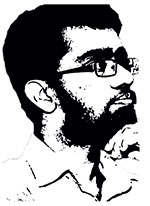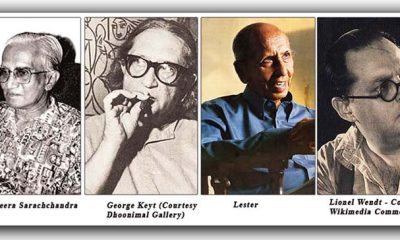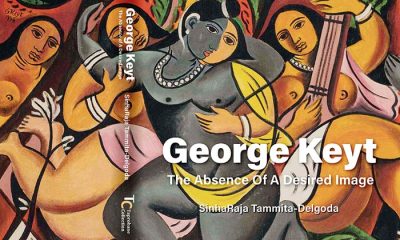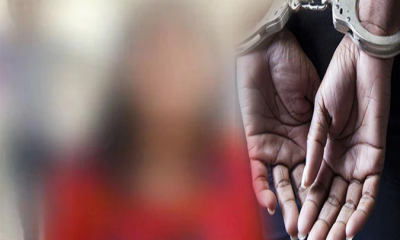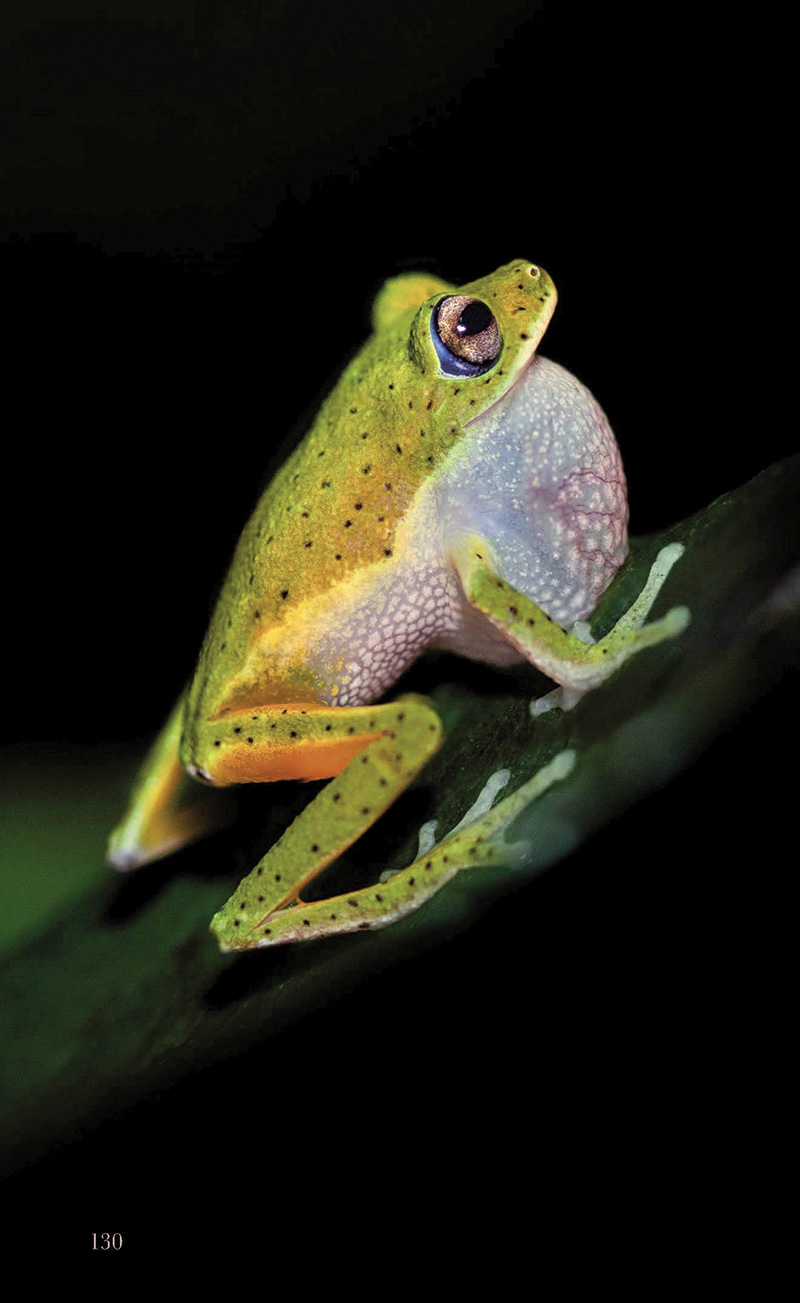Features
G.R. Perera : Reflections on a Career

By Uditha Devapriya
R. Perera, who died last Monday, hailed from the same generation as Sumitra Peries, who passed away in January. A towering hulk of a man, Perera often played characters who did not want to flaunt their strength, who concealed their aggressive streak. This did not make him timid, still less submissive. Whether he was playing a monk or a Mudaliyar, he knew when to be assertive and when to step back. The result was a remarkable combination of bravado and self-restraint that epitomised him. Yet, such a combination served in the end to restrict him: much of the time he had to be content playing secondary roles.
It would be a mistake, however, to view this purely as a limitation. Perera may have been restricted to secondary roles, but even within these limits he gave his best and built up an impressive portfolio of performances. Not all of them ranked at the top of the league, but not all of them ranked at the bottom either: he could play the Mudaliyar (Nidahase Piya) with as much finesse as the servant of the manor (Aswesuma), a henchman (Welikathara) with as much facility as a monk (Giraya). Like Joe Abeywickrema, the greatest character actor Sri Lanka has ever seen, Perera remained, to his last, a chameleonic figure.
Chameleonic, and colourful. When I met him in 2016, he opened himself up, not caring to restrain himself. This may have been because he lived through a very colourful childhood and adolescence. Born in Kirulapone in 1939, Perera was initially educated at Rattanapitiya in Boralesgamuwa. His family moved to Egodawatte, one of the 13 villages which made up Boralesgamuwa, and sent him to Kumara Vidyalaya in Kotahena. It was at Rattanapitiya, in or around 1950, that he met and befriended Tissa Abeysekara. The two of them became good friends, cycling together to Kandy, sampling the latest films and books.
A deeply bilingual man, Perera’s tastes remained decidedly eclectic. He was at ease and at home with both Erskine Caldwell and Martin Wickramasinghe. His own career began with the theatre, specifically with Sugathapala de Silva. There are perhaps many versions of how de Silva came up with a name for his stage troupe, and Perera had his. Apparently the two of them had been brainstorming for names at the Vihara Maha Devi Park for almost two weeks, and along the way several arrack bottles had been, to put it politely, downed. Exasperated and not a little frustrated, on the 12th day Perera had blurted out, “Balahan Sugath, arakku bothal daha thunak oni ne ape kattiyata namak hoyaganna!”
De Silva had paused. “Stop right there!” he had expostulated. Thinking for a while, he had smiled at Perera and declared: “Ape Kattiya we shall be!”
All this led to Perera’s debut in Dharmasiri Wickramaratne’s Ran Thodu, which apparently created such a furore and a sensation that several actors and writers joined them, including Wickrema Bogoda and Premaranjith Tilakaratne. Premaranjith, a fiery radical even during his time, subsequently broke away from Ape Kattiya and formed his own troupe, 63 Kandayama. He persuaded Perera to play a leading role in his debut, Waguru Bima, in 1963. One thing led to another again, and D. B. Nihalsinghe chose him to play a minor though important role in his debut, Welikathara. Perera’s performance there lasts for around 10 minutes: it was shot, he remembered for me, at G. D. L. Perera’s office in Nawinne.
These associations made him an integral part of the social transformations which were sweeping across Sri Lanka at the time. The 1956 election had, for all intents and purposes, emancipated a Sinhala speaking intelligentsia and artistic community, giving them the freedom and the agency to do as they pleased and as they wished. From this emerged an entire generation of bilingual artistes, particularly playwrights, who not only repudiated the classical garb of Sarachchandra’s Maname, but also went out to the world in search of new, exciting dramatic and artistic forms. Perera soon found himself in their company, working alongside with, or making the acquaintance of, the likes of Tilakaratne, Perera, Sumana Aloka Bandara, and Sugathapala de Silva, all of whom hailed from his class.
Certainly, these were formative years, particularly for the Sinhala cinema. Yet Perera did not particularly distinguish himself in film. A tally of less than 60 films, including three Indian, two American, and one German, would hardly constitute a “prodigious” career, after all. Rather, it was in television that the man proved his mark and made a name for himself. Counting in more than 600 television serials and performances, Perera carved a niche for himself as a supporting actor, a feat which eventually broke records and for which he was recognised officially, when some years ago, at the Raigam Awards, he received honours as the actor with the highest number of television appearances.
Unlike most of his contemporaries, Perera did not care to stick to a particular mould or archetype. What binds all his performances together today is that they are all supporting characters. There were one or two roles with which he took the lead, but these were, until his last days, exceptional. A concomitant of this was that none of his performances were ever truly likeable or dislikeable. Their function, as it stood, was to propel the plot, to better reinforce relations between the protagonist and the world around him in the narrative. In Aswesuma, for instance, he is the servant of the manor, whose main function, literally, is to despatch messages between the protagonist, played by Jackson Anthony, and the man who will eventually try to kill him, played by Ravindra Randeniya.
This is not to say that these characters lacked agency. But more often than not, they were deprived of it. With very little to do, they often lingered onscreen, waiting until the script gave them something to act on. But within the confines of his characters, he had very little to do, and catalytic though some of his performances may have been, in the end he refused to take the lead with them. This is the case with his performance as the game hamuduruwo in Giraya: in his attempt at educating villagers, he risks running up against the traditional social order represented by the occupants of the manor, particularly the Walawwa Hamine played by Grace Ariyawimal. But Perera’s monk does not become a complete radical either: he contents himself in educating his people, rather than inciting them to rebel.
The most obvious comparison and contrast that comes to mind is Joe Abeywickrema. Until Welikathara, which coincidentally was Perera’s debut, Abeywickrema remained at best a secondary player, whose roles in film seemed to be that of a consoler, the man who went out of his way to make things happen faster for the protagonist. After Welikathara, things never stayed the same. In both Welikathara and Aswesuma, one notices at once the rift, the contrast, between these two actors: Abeywickrema does not hesitate to take the lead, while Perera does all he can to stay away. In this both were responding to the limitations placed on them by their script, and in both cases, they gave the best they had. It is perhaps a sign of how distinct the one was from the other that although their characters in Welikathara and Aswesuma know each other, these two actors never meet in person.
He remained, to the last, prone to talk. It was impossible to end any conversation you began with him, especially if that conversation centred on subjects close to his heart. And there were quite a number of subjects close to his heart, among them the state of the nation’s theatre. Once, for instance, he had approached the Norwegian Ambassador and proposed a novel idea. “I wanted Sri Lanka to have more complexes outside Colombo. These would be named after playwrights from the world over and funded by the citizens of their respective countries. Norwegians, for instance, could help build a complex named after Ibsen.” Sadly, though the Ambassador had been intrigued, the project never came to be.
Such passions and obsessions dotted Perera’s life, though people would not normally associate him with them. For them, as for most of us, Perera remained an actor, a pretty decent one. Although much can be said and written about the quality of the productions that he took part in – from the high point of Sri Lankan cinema and television in the 1970s and 1980s, we have slipped, badly – it goes without saying that, despite the limits within which he had to perform, he performed well. Perhaps the best example for this would be one of his last roles, as Mudaliyar Don Spater Senanayake in Nidahase Piya. That film left much to be desired, historically, but as the paterfamilias of the Senanayake family, Perera reimagined his role, embodying him, but also individualising him. In the end that became his signature: his ability at assimilating his role, and giving it his own distinct flavour.
The writer is an international relations analyst, researcher, and columnist who can be reached at udakdev1@gmail.com.
Features
Cyclones, greed and philosophy for a new world order

Further to my earlier letter titled, “Psychology of Greed and Philosophy for a New World Order” (The Island 26.11.2025) it may not be far-fetched to say that the cause of the devastating cyclones that hit Sri Lanka and Indonesia last week could be traced back to human greed. Cyclones of this magnitude are said to be unusual in the equatorial region but, according to experts, the raised sea surface temperatures created the conditions for their occurrence. This is directly due to global warming which is caused by excessive emission of Greenhouse gases due to burning of fossil fuels and other activities. These activities cannot be brought under control as the rich, greedy Western powers do not want to abide by the terms and conditions agreed upon at the Paris Agreement of 2015, as was seen at the COP30 meeting in Brazil recently. Is there hope for third world countries? This is why the Global South must develop a New World Order. For this purpose, the proposed contentment/sufficiency philosophy based on morals like dhana, seela, bhavana, may provide the necessary foundation.
Further, such a philosophy need not be parochial and isolationist. It may not be necessary to adopt systems that existed in the past that suited the times but develop a system that would be practical and also pragmatic in the context of the modern world.
It must be reiterated that without controlling the force of collective greed the present destructive socioeconomic system cannot be changed. Hence the need for a philosophy that incorporates the means of controlling greed. Dhana, seela, bhavana may suit Sri Lanka and most of the East which, as mentioned in my earlier letter, share a similar philosophical heritage. The rest of the world also may have to adopt a contentment / sufficiency philosophy with strong and effective tenets that suit their culture, to bring under control the evil of greed. If not, there is no hope for the existence of the world. Global warming will destroy it with cyclones, forest fires, droughts, floods, crop failure and famine.
Leading economists had commented on the damaging effect of greed on the economy while philosophers, ancient as well as modern, had spoken about its degenerating influence on the inborn human morals. Ancient philosophers like Plato, Aristotle, and Epicurus all spoke about greed, viewing it as a destructive force that hindered a good life. They believed greed was rooted in personal immorality and prevented individuals from achieving true happiness by focusing on endless material accumulation rather than the limited wealth needed for natural needs.
Jeffry Sachs argues that greed is a destructive force that undermines social and environmental well-being, citing it as a major driver of climate change and economic inequality, referencing the ideas of Adam Smith, John Maynard Keynes, etc. Joseph Stiglitz, a Nobel Laureate economist, has criticised neoliberal ideology in similar terms.
In my earlier letter, I have discussed how contentment / sufficiency philosophy could effectively transform the socioeconomic system to one that prioritises collective well-being and sufficiency over rampant consumerism and greed, potentially leading to more sustainable economic models.
Obviously, these changes cannot be brought about without a change of attitude, morals and commitment of the rulers and the government. This cannot be achieved without a mass movement; people must realise the need for change. Such a movement would need leadership. In this regard a critical responsibility lies with the educated middle class. It is they who must give leadership to the movement that would have the goal of getting rid of the evil of excessive greed. It is they who must educate the entire nation about the need for these changes.
The middle class would be the vanguard of change. It is the middle class that has the capacity to bring about change. It is the middle class that perform as a vibrant component of the society for political stability. It is the group which supplies political philosophy, ideology, movements, guidance and leaders for the rest of the society. The poor, who are the majority, need the political wisdom and leadership of the middle class.
Further, the middle class is the font of culture, creativity, literature, art and music. Thinkers, writers, artistes, musicians are fostered by the middle class. Cultural activity of the middle class could pervade down to the poor groups and have an effect on their cultural development as well. Similarly, education of a country depends on how educated the middle class is. It is the responsibility of the middle class to provide education to the poor people.
Most importantly, the morals of a society are imbued in the middle class and it is they who foster them. As morals are crucial in the battle against greed, the middle class assume greater credentials to spearhead the movement against greed and bring in sustainable development and growth. Contentment sufficiency philosophy, based on morals, would form the strong foundation necessary for achieving the goal of a new world order. Thus, it is seen that the middle class is eminently suitable to be the vehicle that could adopt and disseminate a contentment/ sufficiency philosophy and lead the movement against the evil neo-liberal system that is destroying the world.
The Global South, which comprises the majority of the world’s poor, may have to realise, before it is too late, that it is they who are the most vulnerable to climate change though they may not be the greatest offenders who cause it. Yet, if they are to survive, they must get together and help each other to achieve self-sufficiency in the essential needs, like food, energy and medicine. Trade must not be via exploitative and weaponised currency but by means of a barter system, based on purchase power parity (PPP). The union of these countries could be an expansion of organisations,like BRICS, ASEAN, SCO, AU, etc., which already have the trade and financial arrangements though in a rudimentary state but with great potential, if only they could sort out their bilateral issues and work towards a Global South which is neither rich nor poor but sufficient, contented and safe, a lesson to the Global North. China, India and South Africa must play the lead role in this venture. They would need the support of a strong philosophy that has the capacity to fight the evil of greed, for they cannot achieve these goals if fettered by greed. The proposed contentment / sufficient philosophy would form a strong philosophical foundation for the Global South, to unite, fight greed and develop a new world order which, above all, will make it safe for life.
by Prof. N. A. de S. Amaratunga
PHD, DSc, DLITT
Features
SINHARAJA: The Living Cathedral of Sri Lanka’s Rainforest Heritage

When Senior biodiversity scientist Vimukthi Weeratunga speaks of Sinharaja, his voice carries the weight of four decades spent beneath its dripping emerald canopy. To him, Sri Lanka’s last great rainforest is not merely a protected area—it is “a cathedral of life,” a sanctuary where evolution whispers through every leaf, stream and shadow.
“Sinharaja is the largest and most precious tropical rainforest we have,” Weeratunga said.
“Sixty to seventy percent of the plants and animals found here exist nowhere else on Earth. This forest is the heart of endemic biodiversity in Sri Lanka.”
A Magnet for the World’s Naturalists
Sinharaja’s allure lies not in charismatic megafauna but in the world of the small and extraordinary—tiny, jewel-toned frogs; iridescent butterflies; shy serpents; and canopy birds whose songs drift like threads of silver through the mist.
“You must walk slowly in Sinharaja,” Weeratunga smiled.
“Its beauty reveals itself only to those who are patient and observant.”
For global travellers fascinated by natural history, Sinharaja remains a top draw. Nearly 90% of nature-focused visitors to Sri Lanka place Sinharaja at the top of their itinerary, generating a deep economic pulse for surrounding communities.
A Forest Etched in History
Centuries before conservationists championed its cause, Sinharaja captured the imagination of explorers and scholars. British and Dutch botanists, venturing into the island’s interior from the 17th century onward, mapped streams, documented rare orchids, and penned some of the earliest scientific records of Sri Lanka’s natural heritage.
These chronicles now form the backbone of our understanding of the island’s unique ecology.
The Great Forest War: Saving Sinharaja
But Sinharaja nearly vanished.
In the 1970s, the government—guided by a timber-driven development mindset—greenlit a Canadian-assisted logging project. Forests around Sinharaja fell first; then, the chainsaws approached the ancient core.
“There was very little scientific data to counter the felling,” Weeratunga recalled.
- Poppie’s shrub frog
- Endemic Scimitar babblers
- Blue Magpie
“But people knew instinctively this was a national treasure.”
The public responded with one of the greatest environmental uprisings in Sri Lankan history. Conservation icons Thilo Hoffmann and Neluwe Gunananda Thera led a national movement. After seven tense years, the new government of 1977 halted the project.
What followed was a scientific renaissance. Leading researchers—including Prof. Savithri Gunathilake and Prof. Nimal Gunathilaka, Prof. Sarath Kottagama, and others—descended into the depths of Sinharaja, documenting every possible facet of its biodiversity.
“Those studies paved the way for Sinharaja to become Sri Lanka’s very first natural World Heritage Site,” Weeratunga noted proudly.
- Vimukthi
- Nadika
- Janaka
A Book Woven From 30 Years of Field Wisdom
For Weeratunga, Sinharaja is more than academic terrain—it is home. Since joining the Forest Department in 1985 as a young researcher, he has trekked, photographed, documented and celebrated its secrets.
Now, decades later, he joins Dr. Thilak Jayaratne, the late Dr. Janaka Gallangoda, and Nadika Hapuarachchi in producing, what he calls, the most comprehensive book ever written on Sinharaja.
“This will be the first major publication on Sinharaja since the early 1980s,” he said.
“It covers ecology, history, flora, fauna—and includes rare photographs taken over nearly 30 years.”
Some images were captured after weeks of waiting. Others after years—like the mysterious mass-flowering episodes where clusters of forest giants bloom in synchrony, or the delicate jewels of the understory: tiny jumping spiders, elusive amphibians, and canopy dwellers glimpsed only once in a lifetime.
The book even includes underwater photography from Sinharaja’s crystal-clear streams—worlds unseen by most visitors.
A Tribute to a Departed Friend
Halfway through the project, tragedy struck: co-author Dr. Janaka Gallangoda passed away.
“We stopped the project for a while,” Weeratunga said quietly.
“But Dr. Thilak Jayaratne reminded us that Janaka lived for this forest. So we completed the book in his memory. One of our authors now watches over Sinharaja from above.”
An Invitation to the Public
A special exhibition, showcasing highlights from the book, will be held on 13–14 December, 2025, in Colombo.
“We cannot show Sinharaja in one gallery,” he laughed.
“But we can show a single drop of its beauty—enough to spark curiosity.”
A Forest That Must Endure
What makes the book special, he emphasises, is its accessibility.
“We wrote it in simple, clear language—no heavy jargon—so that everyone can understand why Sinharaja is irreplaceable,” Weeratunga said.
“If people know its value, they will protect it.”
To him, Sinharaja is more than a rainforest.
It is Sri Lanka’s living heritage.
A sanctuary of evolution.
A sacred, breathing cathedral that must endure for generations to come.
By Ifham Nizam
Features
How Knuckles was sold out

Leaked RTI Files Reveal Conflicting Approvals, Missing Assessments, and Silent Officials
“This Was Not Mismanagement — It Was a Structured Failure”— CEJ’s Dilena Pathragoda
An investigation, backed by newly released Right to Information (RTI) files, exposes a troubling sequence of events in which multiple state agencies appear to have enabled — or quietly tolerated — unauthorised road construction inside the Knuckles Conservation Forest, a UNESCO World Heritage site.
At the centre of the unfolding scandal is a trail of contradictory letters, unexplained delays, unsigned inspection reports, and sudden reversals by key government offices.
“What these documents show is not confusion or oversight. It is a structured failure,” said Dilena Pathragoda, Executive Director of the Centre for Environmental Justice (CEJ), who has been analysing the leaked records.
“Officials knew the legal requirements. They ignored them. They knew the ecological risks. They dismissed them. The evidence points to a deliberate weakening of safeguards meant to protect one of Sri Lanka’s most fragile ecosystems.”
A Paper Trail of Contradictions
RTI disclosures obtained by activists reveal:
Approvals issued before mandatory field inspections were carried out
Three departments claiming they “did not authorise” the same section of the road
A suspiciously backdated letter clearing a segment already under construction
Internal memos flagging “missing evaluation data” that were never addressed
“No-objection” notes do not hold any legal weight for work inside protected areas, experts say.
One senior officer’s signature appears on two letters with opposing conclusions, sent just three weeks apart — a discrepancy that has raised serious questions within the conservation community.
“This is the kind of documentation that usually surfaces only after damage is done,” Pathragoda said. “It shows a chain of administrative behaviour designed to delay scrutiny until the bulldozers moved in.”
The Silence of the Agencies
Perhaps, more alarming is the behaviour of the regulatory bodies.
Multiple departments — including those legally mandated to halt unauthorised work — acknowledged concerns in internal exchanges but issued no public warnings, took no enforcement action, and allowed machinery to continue operating.
“That silence is the real red flag,” Pathragoda noted.
“Silence is rarely accidental in cases like this. Silence protects someone.”
On the Ground: Damage Already Visible
Independent field teams report:
Fresh erosion scars on steep slopes
Sediment-laden water in downstream streams
Disturbed buffer zones
Workers claiming that they were instructed to “complete the section quickly”
Satellite images from the past two months show accelerated clearing around the contested route.
Environmental experts warn that once the hydrology of the Knuckles slopes is altered, the consequences could be irreversible.
CEJ: “Name Every Official Involved”
CEJ is preparing a formal complaint demanding a multi-agency investigation.
Pathragoda insists that responsibility must be traced along the entire chain — from field officers to approving authorities.
“Every signature, every omission, every backdated approval must be examined,” she said.
“If laws were violated, then prosecutions must follow. Not warnings. Not transfers. Prosecutions.”
A Scandal Still Unfolding
More RTI documents are expected to come out next week, including internal audits and communication logs that could deepen the crisis for several agencies.
As the paper trail widens, one thing is increasingly clear: what happened in Knuckles is not an isolated act — it is an institutional failure, executed quietly, and revealed only because citizens insisted on answers.
by Ifham Nizam
-
News5 days ago
Lunuwila tragedy not caused by those videoing Bell 212: SLAF
-

 News4 days ago
News4 days agoLevel III landslide early warning continue to be in force in the districts of Kandy, Kegalle, Kurunegala and Matale
-

 Latest News6 days ago
Latest News6 days agoLevel III landslide early warnings issued to the districts of Badulla, Kandy, Kegalle, Kurunegala, Matale and Nuwara-Eliya
-

 Features6 days ago
Features6 days agoDitwah: An unusual cyclone
-

 Latest News7 days ago
Latest News7 days agoUpdated Payment Instructions for Disaster Relief Contributions
-

 Business2 days ago
Business2 days agoLOLC Finance Factoring powers business growth
-

 News2 days ago
News2 days agoCPC delegation meets JVP for talks on disaster response
-
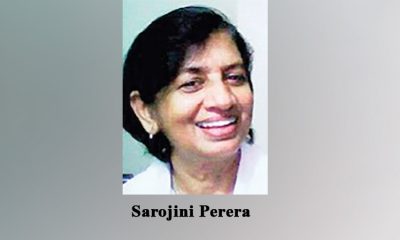
 News2 days ago
News2 days agoA 6th Year Accolade: The Eternal Opulence of My Fair Lady

